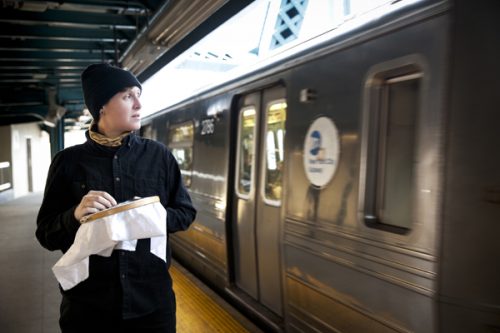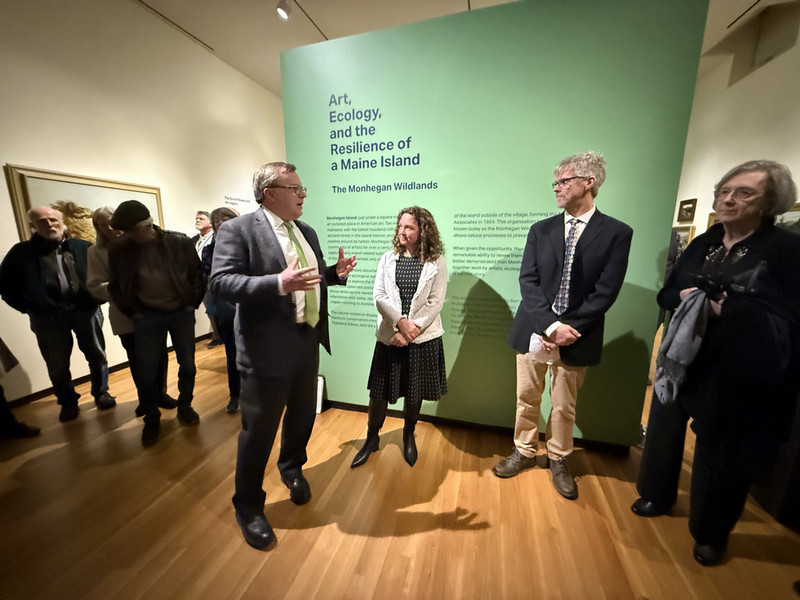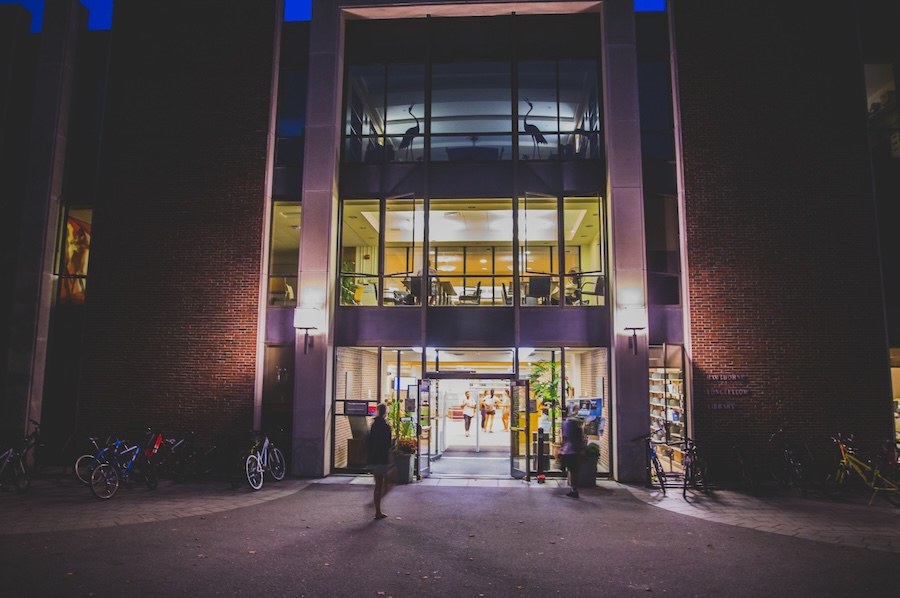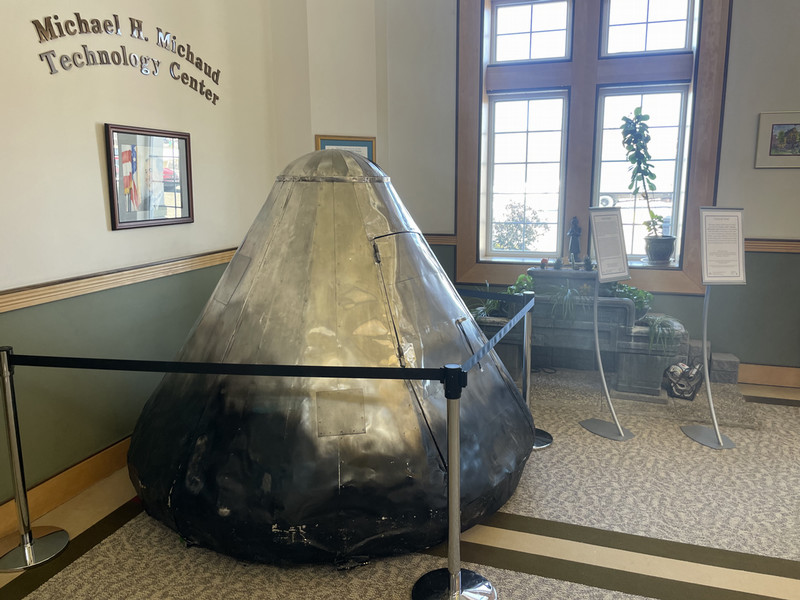Interview with Artist L. J. Roberts
By Bowdoin College Museum of Art
Summer education assistant Hailey Beaman ‘18 recently spoke with artist L. J. Roberts about portraiture, abstraction, and the world of contemporary art. Roberts, who creates politically themed textile works, studied at the University of Vermont and the California College of the Arts. Their work has been shown in galleries and exhibitions nationwide. Roberts created the piece Portrait of Deb (1988-199?) for the Museum’s exhibition This Is a Portrait If I Say So: Identity in American Art, 1912 to Today.
- How did you begin working with textiles? What about this medium and its technique speak to the ideas that are important to your work?
My maternal grandmother taught me to knit when I was seven. She painted and worked in textiles both figuratively and abstractly. She also studied art history, politics, and psychology in a time when women didn’t have a whole lot of access to those fields. Teaching me how to knit was a technique passed down the generations in her family.
I stopped knitting soon after she taught me, frustrated by my lack of coordination. I picked it back up in college at the University of Vermont. I was an English major studying critical literary theory and poetry, but took sculpture classes on the side. I injured myself severely my junior year and couldn’t access the woodshop, video editing lab, or other facilities I typically went to make sculpture. My solution to complete assignments was to try and knit them. The first project I brought to critique was dismissed by a student who called it “craft.” My professor brilliantly tied working in textiles to issues of gender, race, labor, class, amateurism, and other hierarchies that marginalize people. These issues and their intersections were what I studied in my English classes. When I realized the potential of material to communicate political views and identity, it was very powerful and lit a fire under me.
All of this was happening circa 2000-2002. I was struggling with my gender and sexuality and became involved in the queer activist group at college, which was small but very mighty. The campus was politically charged with a lot of opposing views on LGBTQI rights at the time; civil unions were being voted on and there was controversy about letting the Red Cross have blood drives on campus due to their discrimination towards men who have sex with men. I was also acutely aware of the on-going AIDS crisis and was concentrating on youth access to HIV education and prevention for a class I was taking.
I was also living in a radical environmental cooperative with friends who engaged in civil disobedience such as banner drops to protest deforestation and genetic engineering. I would tag along and photograph them. Around this time I did my own banner drop—I knitted a huge pink triangle appliqued with the text “Mom Knows Now” and hung it without permission to the chapel steeple on campus.
This piece was a really critical launch pad into art histories I wasn’t taught in the classroom and eventually connected me with people, mostly in New York, who were doing direct actions and queer activism to advocate for people living with HIV. It also taught me about the accessibility of textiles, which is also a very important part of my practice.
- What do you think is the importance of making socially engaged art in the twenty-first century? And who do you consider to be the ideal audience for your work?
Seeing art with queer content helped me understand myself when I had no vocabulary or visual images that spoke to how I was feeling where I grew up, a conservative suburb of Detroit. I often tell a story about being at an all girls boarding school and going to Washington DC to see the AIDS quilt displayed in its entirety for the last time when I was 15. Of course it was profound and terrifying to see the devastation and scope of the epidemic, but it was also the first time I saw a lexicography of queer symbols. I bought a T-shirt and that was my first piece of ephemera that I considered LGBT, though we know AIDS doesn’t only affect queer people.
When I look at work by Catherine Opie, Felix Gonzalez-Torres, Harmony Hammond, and many others, I am more able to understand myself and the world. Zanele Muholi, the South African photographer calls her work, mostly portraits of Black South African Lesbians who often face terrible violence, “visual activism.” I think this is a really good example of using images to bring politics to the forefront.
Obviously collectives such as Grand Fury, fierce pussy, Dyke Action Machine, and Damned Interfering Video Artists made a huge impact both inside and outside institutions and still provide a model that I follow for how to impact different audiences. I try to make work both inside and outside of galleries and museums. Because of the gender and sex disparities we see in museums and galleries, I feel it’s important to take space AND bring other people into those spaces. I also realize that not everyone has access to museums and galleries, so I often create objects that begin in the museum and exit out into the world and are free to take. Examples of this include buttons, patches, and a safer sex packet that centered on women of varied experiences and identities and provides information about HIV/AIDS.
- This Is a Portrait If I Say So: Identity in American Art, 1912 to Today is an exhibition about abstraction in portraiture. Does abstraction, for you, offer a way of thinking about or seeing a person that traditional forms of portraiture might not?
I think one of the most useful tactics that the concept of “queer” engages is that we can never make assumptions about a person’s identity and that people’s identities are not static, that they are intersectional, and that they change. Abstraction doesn’t often allow for pointed assumptions based on a physical image of the body and I think this is useful. This is not to say that traditional portraits aren’t useful, in fact they are critical; for marginalized people images of people they identify with are often scarce in popular media, though this has begun to turn a bit I think. This Is A Portrait If I Say So is a fabulous experiment in how we communicate highly varied aspects of humanity and a challenge in how we “see” and “read,” which is a primary function of art in my opinion.
- Does your use of found objects in Portrait of Deb, 1988-199? engage the assumed link between portraiture and reality? What role do you understand language and material culture to play in the formation of identity?
When I was given this archive of Deb’s it immediately struck me as a portrait of her based in a specific time and place. This is ephemera from her life and activism during a devastating time. We saw the AIDS crisis decimating marginalized populations, climate change, war, austerity, culture wars, and mass incarceration heighten during this specific time and they continue. Deb’s “stuff” shows the intertwined politics and activism she was involved in.
This felt important to acknowledge because at the time I received the collection and began stitching the piece there was a lot of cultural production, exhibitions, and film that revisited the AIDS crisis in the late ’80s and early to mid ’90s, the time period that Deb’s collection spans. Much of this production concentrated on the narratives of cisgendered white gay men. Deb’s collection shows how feminism, trans and lesbian identities, anti-racist politics, fat activism, and reproductive justice among other issues were critical to the fight against AIDS. There are also many strategies of activism illustrated from humor, to militancy, to public grief, to calls for action. Using embroidery spoke to feminist legacies of art making and activism that were integral during this time.
- Portraits often testify to someone’s existence in the world, and they assume that existence is somehow valuable to society. Does your understanding of portraiture confront this notion—whether in a memorial, documentary, or representational capacity—and if so, how?
I think during this time it’s clear that certain lives matter more than others—we see this all over the world from police brutality towards Black people, to xenophobic attitudes towards migrants, to rampant Islamophobia, to rampant discrimination towards queer and trans people. I think I’ll echo a previous response and say that representations of individuals are helpful in understanding ourselves, though they always carry with them exclusion. When artists, including myself, make a body of work that focuses on portraiture it’s important to ask “who’s not there? and why aren’t they there?” These questions are a reflection of ourselves, our contexts, our communities, and our geographies.



